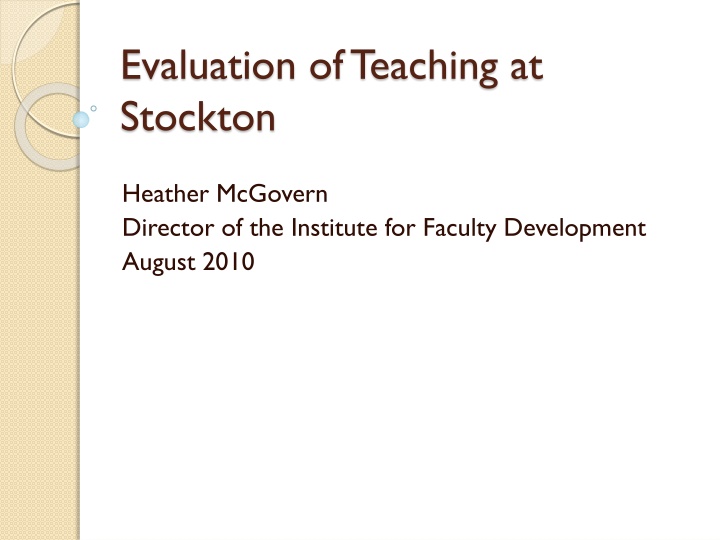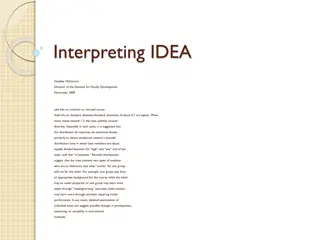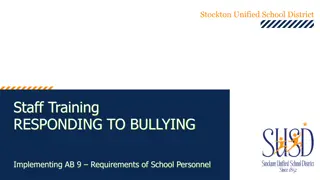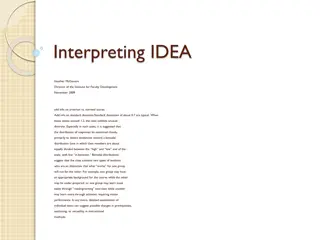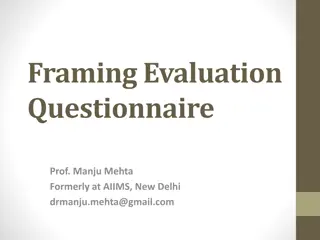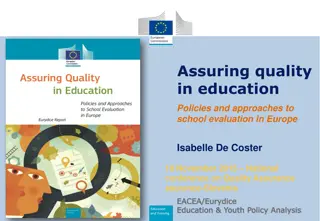Evaluation of Teaching at Stockton: Methods and Recommendations
This document provides insights into the evaluation of teaching practices at Stockton University, focusing on multiple assessment methods such as self-evaluation, student evaluations, peer observations, and building teaching portfolios. It outlines steps for faculty to follow, including selecting objectives, incorporating evaluation time in syllabi, and planning for classroom observations. The emphasis is on enhancing teaching effectiveness and utilizing diverse evaluation approaches for comprehensive assessment.
Uploaded on Oct 06, 2024 | 2 Views
Download Presentation

Please find below an Image/Link to download the presentation.
The content on the website is provided AS IS for your information and personal use only. It may not be sold, licensed, or shared on other websites without obtaining consent from the author.If you encounter any issues during the download, it is possible that the publisher has removed the file from their server.
You are allowed to download the files provided on this website for personal or commercial use, subject to the condition that they are used lawfully. All files are the property of their respective owners.
The content on the website is provided AS IS for your information and personal use only. It may not be sold, licensed, or shared on other websites without obtaining consent from the author.
E N D
Presentation Transcript
Evaluation of Teaching at Stockton Heather McGovern Director of the Institute for Faculty Development August 2010
Resources in your binder Let me give you a guided tour
Overview I. How to know what to do, when, for evaluation of teaching at Stockton II. The role of different items in evaluation of teaching at Stockton III. Student evaluations: A. B. C. D. Choosing learning objectives and disciplinary codes Interpreting data Making comparisons Improving teaching and evaluations VII. Peer observations of teaching VII. Teaching portfolio VII. References
You will provide multiple ways for your teaching to be evaluated. Stockton policy states that evidence of teaching performance should be demonstrated by a teaching portfolio, as outlined below, which should contain the following: A self-evaluation of teaching Student evaluations of teaching and preceptorial teaching Peer evaluations of teaching Other evidence of effectiveness in teaching
Evaluate nearly all courses Untenured faculty will use formal evaluations of teaching in all their classes of 5 or more students You may have any class observed at any time
You need to do some things now. 1) Select objectives. 2) Allow time on syllabi for evaluations from Dec. 1-6. 3) Go online through the Stockton portal and identify which of a list of learning objectives are relevant to your class. Your deadline for doing this is the 2ndprecepting day, Nov. 3. Directions will follow later. 4) When you select learning objectives, double check your disciplinary comparison code, and email me to request changes.
One more thing I recommend you do now: Plan an observation You are not required to have any observations completed in your first semester, but I strongly recommend that you have at least one.
STUDENT EVALUATIONS
To what extent do you value student evaluations as part of evaluation of teaching? 1. Very much 2. Much 3. Some 4. A little 5. Not much
Student evaluations are one part of evaluation of teaching. The IDEA Center strongly recommends that additional sources of evidence be used when teaching is evaluated and that student ratings constitute only 30% to 50% of the overall evaluation of teaching. Primary reasons: o some components of effective teaching are best judged by peers and not students o it is always useful to triangulate information... o no instrument is fully valid o no instrument is fully reliable
Student teaching evaluations are valid they correlate with others ratings Administrator Colleagues Alumni Trained observers Student comments .75 to .93 .39 to .62 .48 to .69 .40 to .70 .50 to .76
Quick, simplified definitionsno insult intended! Validity: it measures what it says it measures Reliability: measures will tend to be consistent, repeatable Representative: the people responding would be likely to be typical of the whole group
Student evaluations are valid: They correlate with external tests at a rate that is practically useful Correlation studies of multi-section course instructor ratings to external tests yield the following: Achievement of learning Overall course Overall instructor .47 .47 .44
Student evaluations cannot measure everything Of 26 factors Cashin (1989) identifies as relevant to teaching effectiveness, there are eleven which students cannot assess. Keig and Waggoner (1994) grouped these into three categories: (1) the goals, content, and organization of course design, (2) methods and materials used in delivery, and (3) evaluation of student work, including grading practices.
How Stockton defines excellence in teaching and what students rate A thorough and current command of the subject matter, teaching techniques and methodologies of the discipline one teaches Sound course design and delivery in all teaching assignments as evident in clear learning goals and expectations, content reflecting the best available scholarship or artistic practices, and teaching techniques aimed at student learning The ability to organize course material and to communicate this information effectively. The development of a comprehensive syllabus for each course taught, including expectations, grading and attendance policies, and the timely provision of copies to students. respect for students as members of the Stockton academic community, the effective response to student questions, and the timely evaluation of and feedback to students. Where appropriate, additional measures of teaching excellence are Ability to use technology in teaching The capacity to relate the subject matter to other fields of knowledge Seeking opportunities outside the classroom to enhance student learning of the subject matter
Reliability and representativeness: Number of classes needed for evaluation The IDEA Center recommends using six to eight classes, not necessarily all from the same academic year, that are representative of all of an instructor s teaching responsibilities. In a person s first few years at Stockton, evaluators will not be able to do what is ideal. This makes having teaching observations and other evidence of good teaching in your file even more important.
The number of student responders affects reliability The number of student respondents affects reliability. In this context, reliability refers to consistency, interrater reliability. IDEA reports the following median rates: 10 raters .69 reliability 15 raters .83 reliability 20 raters .83 reliability 30 raters .88 reliability 40 raters .91 reliability Reliability ratings below .70 are highly suspect. Starting in Fall 2010, to respond to this issue, we re using a different form for classes of fewer than 15 students, following the last day to withdraw. But faculty may have unreliable data already in their files.
The number of student responders affects representativeness Higher response rates provide more representative data. Lower response rates provide less representative data. This is especially an area of concern for classes using the online IDEA which has a lower response rate. In Fall 2008, the online response rate was 62.9%, and in Spring 2009, 71.5%. But any class (even a small one) can have a low response rate, and if this happens in your class you should note it for file readers and note it yourself.
Selecting Objectives and Checking Your Disciplinary Code Look at the faculty information form so you can see the objectives from which you can choose Look at the sample IDEA report.
The objectives you choose matter. Item A. on page one and column one in the graph report Progress on Relevant Objectives. The Summary Evaluation provided on page one of the IDEA report weights Progress toward Relevant Objectives at 50% and Excellent Teacher and Excellent Course at 25%. Data on page two reports student ratings on only the items you selected. Data on page four reports all ratings. On the small class form, students will list objectives they feel they progressed on.
It matters whether you say something is important or essential. In the IDEA Progress toward Relevant Objectives scores on page one of the report, items of minor importance do not count at all, and items that are essential count double items that are important. Your choice also sends a signal about your philosophy of teaching for the class.
Which objectives should I select? Those that make sense for your class! For example, if you teach a writing class, logically the objective about progress developing communication skills should be essential.
How can you know whether something is important enough to select? Pedagogy and assignments help students progress on the objective A significant portion of a student s grade is comprised of a meaningful measurement of how well students have achieved that objective
Consider program requests Your program may have some suggestions or requests about what you select (e.g., the writing program and first year seminars suggest objectives for W and first year seminar classes, and science lab courses often have a supervisor who suggests objectives). Programs cannot force selections upon you, but they may have good reasons for requesting that people make similar choices, and/or program guidance can make selecting objectives easier for you.
How many of the 12 objectives would you guess might usually be a good number to choose? 1. 1-2 2. 3-5 3. 6-8 4. 9-12
How many objectives should I select? Usually, 3-5. You should select at least one objective as either important or essential, but selecting too many is often problematic. It is harder for students to make progress if the class has many objectives. Research indicates that student ratings tend to decrease when larger numbers of objectives are selected.
Myths about objectives I have to choose 3. No. If you choose none as important or essential, then by default all will be important, which is not good. But you could select as few as one or as many as all of them. Best practice would be to select 3-5. I have to have at least one essential or I have to have at least one important. No. You can have any combination of important and essential objectives. You could have none selected as essential, and only some as important. You could have none selected as important, and only some as essential. Note: if all your selections are essential or important, they ll be equally weighted and it won t matter mathematically whether they are essential or important. It doesn t matter what I select.
Activity Choose objectives for one of the classes you will teach this fall. Defend those choices with a partner.
Selecting a disciplinary code Ideally, your code is as good a match to your class as possible. A match has been selected for you. If it is good, do nothing. If you think it could be better, contact me about a possible new one.
Remember that the results report Student evaluations give you students perceptions, which are not always the same as student learning or as reality.
How would you describe DF as a teacher, based on the means (on a 5 point scale) in A-D on page one? 1. Excellent 2. Good 3. Ok 4. Sub-par 5. Terrible
How would you describe DF as a teacher, based on the graph on page 1? 1. Excellent 2. Good 3. Ok 4. Sub-par 5. Terrible
Outlier can affect mean scores. IDEA reports mean scores, which can be affected by outliers. Careful evaluators will check the statistical detail on page 4. Standard deviations of .7 are typical. Standard deviations of over 1.2 indicate unusual diversity. If the distribution is bimodal, then the class may have contained two types of students who are so distinctive that what works for one group will not for the other. For example, one group may have an appropriate background for the course while the other may be under-prepared . (IDEA) They recommended detailed item examination; there may be issues beyond instructor control.
Scores and comments can be affected by the halo effect Ranters and Ravers, or the halo effect the tendency of raters to form a general opinion of the person being rated and then let that opinion color all specific ratings. If the general impression is favorable, the "halo effect" is positive and the individual receives higher ratings on many items than a more objective evaluation would justify. The "halo effect" can also be negative; an unfavorable general impression will lead to low marks "across the board", even in areas where performance is strong.
How can you know? Look at the pattern of student responses on page 4 or on the student forms. If a form gives someone a 5 all the way down, regardless of whether a class covered a particular learning objective halo effect! In most cases, also true with a 1 or any other number all the way down
The Error of Central Tendency can affect scores Most people have a tendency to avoid the extremes (very high and very low) in making ratings. As a result, ratings tend to pile up more toward the middle of the rating scale than might be justified. In many cases, ratings which are "somewhat below average" or "somewhat above average" may represent subdued estimates of an individual's status because of the "Error of Central Tendency.
Things evaluators should check The teacher selected objectives. If not, by default, all will be considered important. Much information on the first page of the report is worthless. The objectives the teacher chose seem reasonable for the course. The teacher discusses problematic objective choices or irregularities in the class.
You can help evaluators by noting if you forgot to select objectives, which seriously impacts the results later see that you chose objectives poorly were using objectives in common with a larger group of courses, but those were problematic for your class need to report an unusual situation that likely affected student progress towards objectives or student perception of the class
IDEA compares class results to three groups (page one and two) 1) Three years of IDEA student ratings at 122 institutions in 73, 722 classes (excluding classes with fewer than 10 students, limiting to no more than 5% of database from any one institution, excluding first time institutions) 2) Classes at your institution in the most recent five years (excluding classes with no objectives selected, including classes of all sizes) 3) Classes in the same discipline in the most recent five years where at least 400 classes with the same disciplinary code were rated (excluding as in 1, plus courses with no selected objectives)
The validity of comparisons varies The validity of comparisons depends on a number of factors, including how typical a class is, compared to classes at Stockton or all classes in the IDEA database or how well the class aligns with other classes with the same IDEA disciplinary code. Some classes at Stockton align poorly with typical classes say, a fieldwork class or a class with an cutting-edge format.
External factors can affect comparisons and ratings Students in required courses tend to report lower. Students in lower level classes tend to report lower. Arts and humanities >social science > math (this may be because of differences in teaching quality or due to quantitative nature of courses, both, or other factors). Gender/age/race/culture/height/physical attractiveness and more may be factors, as they are in many other areas of life. If the students are told the evaluation will be used in personnel decisions the scores are higher. If the instructor is present during the evaluation the scores are higher.
Some external factors dont usually affect ratings Time of day of the course Time in the term in which evaluations are given (after midterm) Age of student Level of student Student GPA
Some disciplinary comparisons are suspect Many classes align poorly with disciplinary codes: CRIM stats here, which is compared either with Criminal Justice or with Mathematics. Or developmental writing here, which is higher level than many but also for credit. Or most of our G courses, perhaps particularly our GIS courses.
We should use converted scores when making comparisons IDEA states that Institutions that want to make judgments about teaching effectiveness on a comparative basis should use converted scores. Converted scores are reported in the graph and lower table on page one and on page two.
Why we should use converted scores The 5-point averages of progress ratings on Essential or Important objectives vary across objective. For instance, the average for gaining factual knowledge is 4.00, while that for gaining a broader understanding and appreciation for intellectual/cultural activity is 3.69. Unconverted averages disadvantage broad liberal education objectives. Using converted averages ensures that instructors choosing objectives where average progress ratings are relatively low will not be penalized for choosing objectives that are particularly challenging or that address complex cognitive skills.
Why we should use adjusted averages in most cases Adjusted scores adjust for student motivation, student work habits, class size, course difficulty, and student effort. Therefore, in most circumstances, the IDEA Center recommends using adjusted scores.
How are they adjusted? Work Habits (mean of Item 43, As a rule, I put forth more effort than other students on academic work) is generally the most potent predictor Unless ratings are adjusted, the instructors of such classes would have an unfair advantage over colleagues with less dedicated students.
How are they adjusted, part II Course Motivation (mean of Item 39, I really wanted to take this course regardless of who taught it) is the second most potent predictor. unless ratings are adjusted, the instructors of such classes would have an unfair advantage over colleagues with less motivated students.
